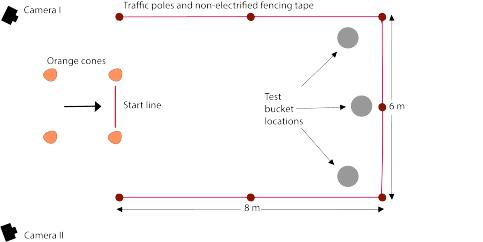Method
Selection of horses
A total of 36 privately owned horses of varius breeds, both mares and geldings, were recruited from an open call. The mean age of the horses was 10.64 years (+/- 0.87 SE). There were four inclusion criteria:
- the horses were stabled within relative geographical proximity to Linköping university in the South east of Sweden
- the stable had access to a confined space such as a riding arena
- the owners visited their horses at least five to six days a week
- the horses were not previously trained with positive reinforcment
Each horse was tested twice in it’s home environment, once at the start of the treatment period in September 2020 and then again at the end of the treatment period in December 2020. All horses were handled by their owners during the study.
Treatment
After the first test the horses were pseudorandomly assigned to either a treatment (N=17) or control group (N=19). The owners of the treatment horses were instructed to follow a training plan with exercises based on positive reinforcement for eight to nine weeks, until their next scheduled test occasion. They were asked to do at least five minutes of positive reinforcement training four times a week in addition to their regular riding and training for the duration of the treatment period. The owners of the control horses were instructed to continue with their regular riding and training but to additionally feed their horses extra carrots during their regular feeding times.
Test setup

A portable arena of six by eight meters was built for each test occasion in a grass-free location. It consisted of plastic traffic poles and non-electrified fencing tape [Figure 1]. For the cognitive bias test the arena was opened on the left side and two pairs of orange cones demarcated the entrance and the start line. Two Canon Legria cameras were set up on tripods facing the front of the arena, one on each side.
Data analysis
The video recordings of the motionless human test were scored according to the ethogram [see Motionless human test, Figure 2]. The data were analysed using IBM SPSS Statistics 27. Non-parametric tests were used as the data were not normally distributed. Mann-Whitney U tests were performed to determine any significant differences between the treatment and control groups with regards to number of trials needed to reach learning criterion, latency to approach the ambiguous bucket, proximity and physical contact during motionless human test, frequency of stess-related behaviours during motionless human test, differences in hair cortisol levels and relationship questionnaire scores. Wilcoxon tests were used to determine whether there were any significant differences before and after the treatmet period for the treatment and control groups with regards to the same variables.
Responsible for this page:
Director of undergraduate studies Biology
Last updated:
05/17/21
